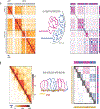Two major mechanisms of chromosome organization
- PMID: 31228682
- PMCID: PMC6800258
- DOI: 10.1016/j.ceb.2019.05.001
Two major mechanisms of chromosome organization
Abstract
The spatial organization of chromosomes has long been connected to their polymeric nature and is believed to be important for their biological functions, including the control of interactions between genomic elements, the maintenance of genetic information, and the compaction and safe transfer of chromosomes to cellular progeny. chromosome conformation capture techniques, particularly Hi-C, have provided a comprehensive picture of spatial chromosome organization and revealed new features and elements of chromosome folding. Furthermore, recent advances in microscopy have made it possible to obtain distance maps for extensive regions of chromosomes (Bintu et al., 2018; Nir et al., 2018 [2••,3]), providing information complementary to, and in excellent agreement with, Hi-C maps. Not only has the resolution of both techniques advanced significantly, but new perturbation data generated in the last two years have led to the identification of molecular mechanisms behind large-scale genome organization. Two major mechanisms that have been proposed to govern chromosome organization are (i) the active (ATP-dependent) process of loop extrusion by Structural Maintenance of Chromosomes (SMC) complexes, and (ii) the spatial compartmentalization of the genome, which is likely mediated by affinity interactions between heterochromatic regions (Falk et al., 2019 [76••]) rather than by ATP-dependent processes. Here, we review existing evidence that these two processes operate together to fold chromosomes in interphase and that loop extrusion alone drives mitotic compaction. We discuss possible implications of these mechanisms for chromosome function.
Copyright © 2019 Elsevier Ltd. All rights reserved.
Conflict of interest statement
Conflict of Interest
The authors declare no conflict of interest.
Figures



References
-
- Marko JF, Siggia ED: Stretching DNA. Macromolecules 1995, 28:8759–8770.
-
-
Bintu B, Mateo LJ, Su J-H, Sinnott-Armstrong NA, Parker M, Kinrot S, Yamaya K, Boettiger AN, Zhuang X: Super-resolution chromatin tracing reveals domains and cooperative interactions in single cells. Science 2018, 362.
(**) Distance maps obtained by microscopy show small distance for loci within, and larger between, TADs. Upon cohesin depletion, intra-TAD distances go up. This decompaction upon loss of cohesin is consistent with loop extrusion and was proposed in Fudenberg et al 2016.
-
-
- Korzybski A: Science and sanity: an introduction to non-Aristotelian systems and general semantics. The International Non-Aristotelian Library Pub. Co.; 1933.
Publication types
MeSH terms
Substances
Grants and funding
LinkOut - more resources
Full Text Sources
Miscellaneous

